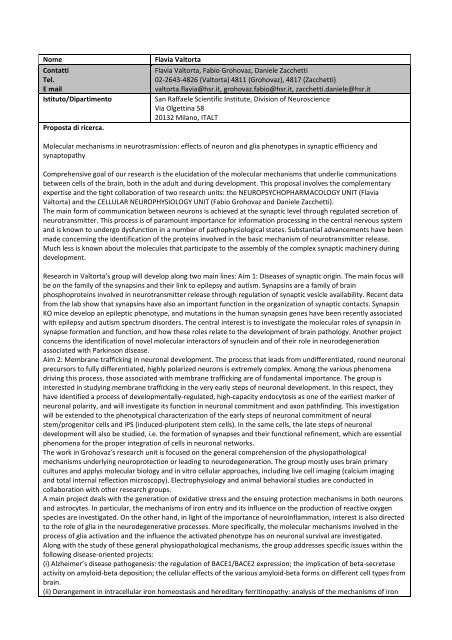Mapping of Italian research excellence in Neurodegenerative - Apre
Mapping of Italian research excellence in Neurodegenerative - Apre
Mapping of Italian research excellence in Neurodegenerative - Apre
You also want an ePaper? Increase the reach of your titles
YUMPU automatically turns print PDFs into web optimized ePapers that Google loves.
Nome Flavia Valtorta<br />
Contatti<br />
Tel.<br />
E mail<br />
Flavia Valtorta, Fabio Grohovaz, Daniele Zacchetti<br />
02-2643-4826 (Valtorta) 4811 (Grohovaz), 4817 (Zacchetti)<br />
valtorta.flavia@hsr.it, grohovaz.fabio@hsr.it, zacchetti.daniele@hsr.it<br />
Istituto/Dipartimento San Raffaele Scientific Institute, Division <strong>of</strong> Neuroscience<br />
Via Olgett<strong>in</strong>a 58<br />
20132 Milano, ITALT<br />
Proposta di ricerca.<br />
Molecular mechanisms <strong>in</strong> neurotrasmission: effects <strong>of</strong> neuron and glia phenotypes <strong>in</strong> synaptic efficiency and<br />
synaptopathy<br />
Comprehensive goal <strong>of</strong> our <strong>research</strong> is the elucidation <strong>of</strong> the molecular mechanisms that underlie communications<br />
between cells <strong>of</strong> the bra<strong>in</strong>, both <strong>in</strong> the adult and dur<strong>in</strong>g development. This proposal <strong>in</strong>volves the complementary<br />
expertise and the tight collaboration <strong>of</strong> two <strong>research</strong> units: the NEUROPSYCHOPHARMACOLOGY UNIT (Flavia<br />
Valtorta) and the CELLULAR NEUROPHYSIOLOGY UNIT (Fabio Grohovaz and Daniele Zacchetti).<br />
The ma<strong>in</strong> form <strong>of</strong> communication between neurons is achieved at the synaptic level through regulated secretion <strong>of</strong><br />
neurotransmitter. This process is <strong>of</strong> paramount importance for <strong>in</strong>formation process<strong>in</strong>g <strong>in</strong> the central nervous system<br />
and is known to undergo dysfunction <strong>in</strong> a number <strong>of</strong> pathophysiological states. Substantial advancements have been<br />
made concern<strong>in</strong>g the identification <strong>of</strong> the prote<strong>in</strong>s <strong>in</strong>volved <strong>in</strong> the basic mechanism <strong>of</strong> neurotransmitter release.<br />
Much less is known about the molecules that participate to the assembly <strong>of</strong> the complex synaptic mach<strong>in</strong>ery dur<strong>in</strong>g<br />
development.<br />
Research <strong>in</strong> Valtorta’s group will develop along two ma<strong>in</strong> l<strong>in</strong>es: Aim 1: Diseases <strong>of</strong> synaptic orig<strong>in</strong>. The ma<strong>in</strong> focus will<br />
be on the family <strong>of</strong> the synaps<strong>in</strong>s and their l<strong>in</strong>k to epilepsy and autism. Synaps<strong>in</strong>s are a family <strong>of</strong> bra<strong>in</strong><br />
phosphoprote<strong>in</strong>s <strong>in</strong>volved <strong>in</strong> neurotransmitter release through regulation <strong>of</strong> synaptic vesicle availability. Recent data<br />
from the lab show that synaps<strong>in</strong>s have also an important function <strong>in</strong> the organization <strong>of</strong> synaptic contacts. Synaps<strong>in</strong><br />
KO mice develop an epileptic phenotype, and mutations <strong>in</strong> the human synaps<strong>in</strong> genes have been recently associated<br />
with epilepsy and autism spectrum disorders. The central <strong>in</strong>terest is to <strong>in</strong>vestigate the molecular roles <strong>of</strong> synaps<strong>in</strong> <strong>in</strong><br />
synapse formation and function, and how these roles relate to the development <strong>of</strong> bra<strong>in</strong> pathology. Another project<br />
concerns the identification <strong>of</strong> novel molecular <strong>in</strong>teractors <strong>of</strong> synucle<strong>in</strong> and <strong>of</strong> their role <strong>in</strong> neurodegeneration<br />
associated with Park<strong>in</strong>son disease.<br />
Aim 2: Membrane traffick<strong>in</strong>g <strong>in</strong> neuronal development. The process that leads from undifferentiated, round neuronal<br />
precursors to fully differentiated, highly polarized neurons is extremely complex. Among the various phenomena<br />
driv<strong>in</strong>g this process, those associated with membrane traffick<strong>in</strong>g are <strong>of</strong> fundamental importance. The group is<br />
<strong>in</strong>terested <strong>in</strong> study<strong>in</strong>g membrane traffick<strong>in</strong>g <strong>in</strong> the very early steps <strong>of</strong> neuronal development. In this respect, they<br />
have identified a process <strong>of</strong> developmentally-regulated, high-capacity endocytosis as one <strong>of</strong> the earliest marker <strong>of</strong><br />
neuronal polarity, and will <strong>in</strong>vestigate its function <strong>in</strong> neuronal commitment and axon pathf<strong>in</strong>d<strong>in</strong>g. This <strong>in</strong>vestigation<br />
will be extended to the phenotypical characterization <strong>of</strong> the early steps <strong>of</strong> neuronal commitment <strong>of</strong> neural<br />
stem/progenitor cells and iPS (<strong>in</strong>duced-pluripotent stem cells). In the same cells, the late steps <strong>of</strong> neuronal<br />
development will also be studied, i.e. the formation <strong>of</strong> synapses and their functional ref<strong>in</strong>ement, which are essential<br />
phenomena for the proper <strong>in</strong>tegration <strong>of</strong> cells <strong>in</strong> neuronal networks.<br />
The work <strong>in</strong> Grohovaz’s <strong>research</strong> unit is focused on the general comprehension <strong>of</strong> the physiopathological<br />
mechanisms underly<strong>in</strong>g neuroprotection or lead<strong>in</strong>g to neurodegeneration. The group mostly uses bra<strong>in</strong> primary<br />
cultures and applys molecular biology and <strong>in</strong> vitro cellular approaches, <strong>in</strong>clud<strong>in</strong>g live cell imag<strong>in</strong>g (calcium imag<strong>in</strong>g<br />
and total <strong>in</strong>ternal reflection microscopy). Electrophysiology and animal behavioral studies are conducted <strong>in</strong><br />
collaboration with other <strong>research</strong> groups.<br />
A ma<strong>in</strong> project deals with the generation <strong>of</strong> oxidative stress and the ensu<strong>in</strong>g protection mechanisms <strong>in</strong> both neurons<br />
and astrocytes. In particular, the mechanisms <strong>of</strong> iron entry and its <strong>in</strong>fluence on the production <strong>of</strong> reactive oxygen<br />
species are <strong>in</strong>vestigated. On the other hand, <strong>in</strong> light <strong>of</strong> the importance <strong>of</strong> neuro<strong>in</strong>flammation, <strong>in</strong>terest is also directed<br />
to the role <strong>of</strong> glia <strong>in</strong> the neurodegenerative processes. More specifically, the molecular mechanisms <strong>in</strong>volved <strong>in</strong> the<br />
process <strong>of</strong> glia activation and the <strong>in</strong>fluence the activated phenotype has on neuronal survival are <strong>in</strong>vestigated.<br />
Along with the study <strong>of</strong> these general physiopathological mechanisms, the group addresses specific issues with<strong>in</strong> the<br />
follow<strong>in</strong>g disease-oriented projects:<br />
(i) Alzheimer’s disease pathogenesis: the regulation <strong>of</strong> BACE1/BACE2 expression; the implication <strong>of</strong> beta-secretase<br />
activity on amyloid-beta deposition; the cellular effects <strong>of</strong> the various amyloid-beta forms on different cell types from<br />
bra<strong>in</strong>.<br />
(ii) Derangement <strong>in</strong> <strong>in</strong>tracellular iron homeostasis and hereditary ferrit<strong>in</strong>opathy: analysis <strong>of</strong> the mechanisms <strong>of</strong> iron


